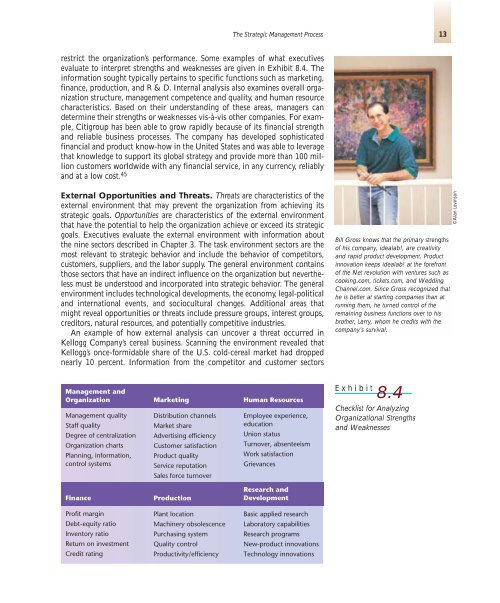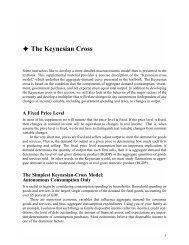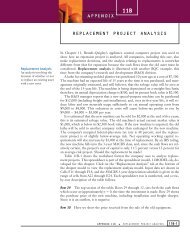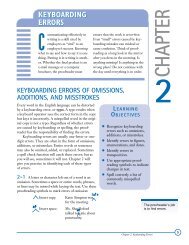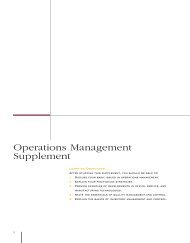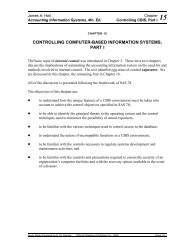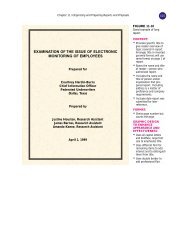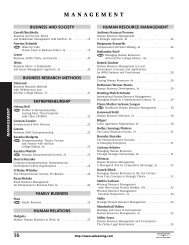chapter 8: strategy formulation and implementation
chapter 8: strategy formulation and implementation
chapter 8: strategy formulation and implementation
Create successful ePaper yourself
Turn your PDF publications into a flip-book with our unique Google optimized e-Paper software.
estrict the organization’s performance. Some examples of what executives<br />
evaluate to interpret strengths <strong>and</strong> weaknesses are given in Exhibit 8.4. The<br />
information sought typically pertains to specific functions such as marketing,<br />
finance, production, <strong>and</strong> R & D. Internal analysis also examines overall organization<br />
structure, management competence <strong>and</strong> quality, <strong>and</strong> human resource<br />
characteristics. Based on their underst<strong>and</strong>ing of these areas, managers can<br />
determine their strengths or weaknesses vis-à-vis other companies. For example,<br />
Citigroup has been able to grow rapidly because of its financial strength<br />
<strong>and</strong> reliable business processes. The company has developed sophisticated<br />
financial <strong>and</strong> product know-how in the United States <strong>and</strong> was able to leverage<br />
that knowledge to support its global <strong>strategy</strong> <strong>and</strong> provide more than 100 million<br />
customers worldwide with any financial service, in any currency, reliably<br />
<strong>and</strong> at a low cost. 45<br />
External Opportunities <strong>and</strong> Threats. Threats are characteristics of the<br />
external environment that may prevent the organization from achieving its<br />
strategic goals. Opportunities are characteristics of the external environment<br />
that have the potential to help the organization achieve or exceed its strategic<br />
goals. Executives evaluate the external environment with information about<br />
the nine sectors described in Chapter 3. The task environment sectors are the<br />
most relevant to strategic behavior <strong>and</strong> include the behavior of competitors,<br />
customers, suppliers, <strong>and</strong> the labor supply. The general environment contains<br />
those sectors that have an indirect influence on the organization but nevertheless<br />
must be understood <strong>and</strong> incorporated into strategic behavior. The general<br />
environment includes technological developments, the economy, legal-political<br />
<strong>and</strong> international events, <strong>and</strong> sociocultural changes. Additional areas that<br />
might reveal opportunities or threats include pressure groups, interest groups,<br />
creditors, natural resources, <strong>and</strong> potentially competitive industries.<br />
An example of how external analysis can uncover a threat occurred in<br />
Kellogg Company’s cereal business. Scanning the environment revealed that<br />
Kellogg’s once-formidable share of the U.S. cold-cereal market had dropped<br />
nearly 10 percent. Information from the competitor <strong>and</strong> customer sectors<br />
Management <strong>and</strong><br />
Organization Marketing Human Resources<br />
Management quality<br />
Staff quality<br />
Degree of centralization<br />
Organization charts<br />
Planning, information,<br />
control systems<br />
Finance<br />
Profit margin<br />
Debt-equity ratio<br />
Inventory ratio<br />
Return on investment<br />
Credit rating<br />
Distribution channels<br />
Market share<br />
Advertising efficiency<br />
Customer satisfaction<br />
Product quality<br />
Service reputation<br />
Sales force turnover<br />
Production<br />
Plant location<br />
Machinery obsolescence<br />
Purchasing system<br />
Quality control<br />
Productivity/efficiency<br />
The Strategic Management Process 13<br />
Employee experience,<br />
education<br />
Union status<br />
Turnover, absenteeism<br />
Work satisfaction<br />
Grievances<br />
Research <strong>and</strong><br />
Development<br />
Basic applied research<br />
Laboratory capabilities<br />
Research programs<br />
New-product innovations<br />
Technology innovations<br />
Bill Gross knows that the primary strengths<br />
of his company, idealab!, are creativity<br />
<strong>and</strong> rapid product development. Product<br />
innovation keeps idealab! at the forefront<br />
of the Net revolution with ventures such as<br />
cooking.com, tickets.com, <strong>and</strong> Wedding<br />
Channel.com. Since Gross recognized that<br />
he is better at starting companies than at<br />
running them, he turned control of the<br />
remaining business functions over to his<br />
brother, Larry, whom he credits with the<br />
company’s survival.<br />
Exhibit<br />
8.4<br />
Checklist for Analyzing<br />
Organizational Strengths<br />
<strong>and</strong> Weaknesses<br />
©Alan Levinson


